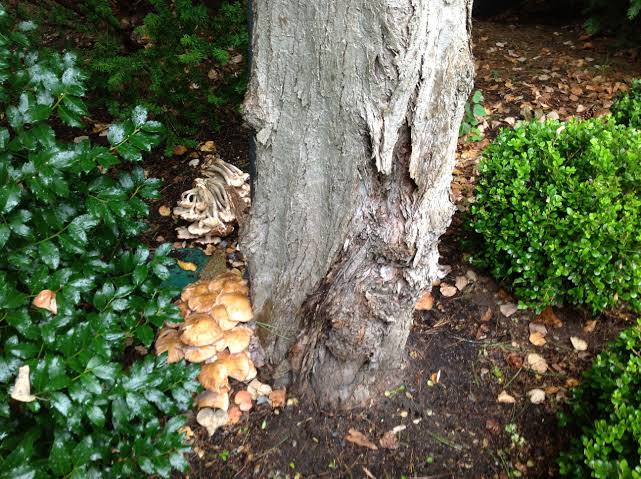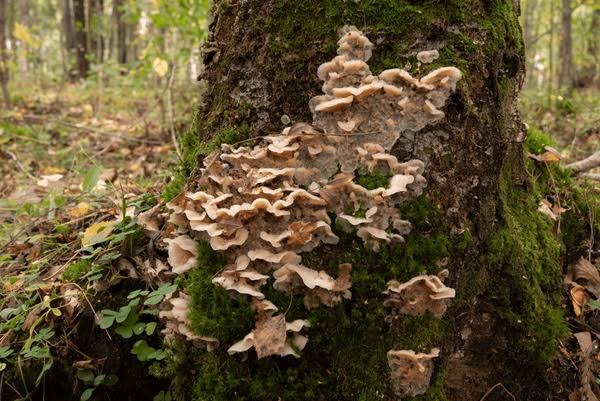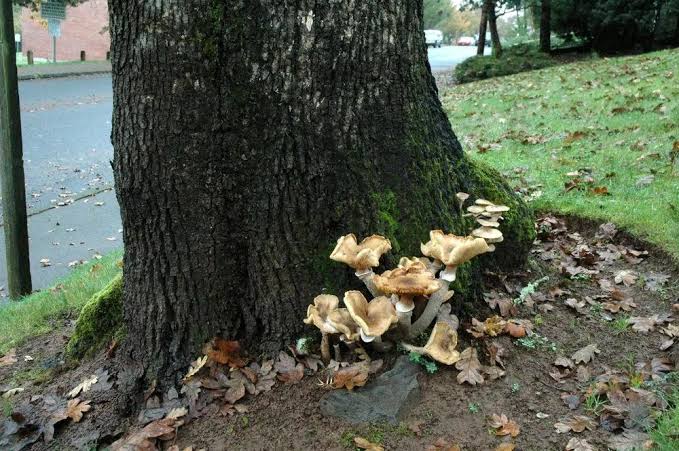Armillaria Root Rot: Description, Damages Caused, Control and Preventive Measures
Armillaria root rot, also known as oak root fungus, is a plant disease caused by fungi belonging to the Armillaria genus. The scientific name for this destructive pathogen is Armillaria mellea.
This fungal infection primarily affects the roots of various trees, including oaks, and poses a significant threat to the health and vitality of these woody plants. The fungus operates by infecting the roots, ultimately leading to the decay of the root system. As the infection progresses, it can compromise the tree’s ability to absorb water and nutrients, resulting in weakened and, eventually, dead trees.
Armillaria root rot is a persistent and widespread problem in many forested areas and can also affect fruit trees and ornamental plants. The fungus thrives in damp and cool conditions, making it particularly problematic in regions with moist climates.
One of the distinctive characteristics of Armillaria root rot is the presence of dark, boot-shaped structures called rhizomorphs. These structures enable the fungus to spread through the soil, connecting healthy trees and facilitating the transmission of the infection. Additionally, the fungus produces mushroom-like structures called honey fungi, which emerge during the late summer and fall. These mushrooms release spores, contributing to the further dissemination of the pathogen.
Detection of Armillaria root rot can be challenging, as symptoms may not manifest until the disease has advanced. Early signs include wilting, yellowing of foliage, and a decline in overall tree vigor. As the infection progresses, cankers may develop on the bark, and the presence of fungal mycelium can be observed beneath the bark’s surface.
Preventative measures against Armillaria root rot include promoting good tree health through proper pruning, maintaining well-drained soil, and avoiding unnecessary stress to the trees. However, once a tree is infected, there is no known cure, and management typically involves removing and disposing of infected trees to prevent the further spread of the fungus.
However, Armillaria root rot, caused by Armillaria mellea, is a destructive fungal disease affecting the roots of various trees, with oaks being particularly susceptible. This pathogen poses a significant threat to forest ecosystems and cultivated landscapes, necessitating proactive measures to prevent and manage its impact.
Read Also: Cutworms: Description, Damages Caused, Control and Preventive Measures
Plants Affected by Armillaria Root Rot (Armillaria mellea)

Armillaria root rot can affect a wide range of plants, with trees being the primary targets. Various hardwood and softwood tree species may fall victim to this destructive fungal infection. Commonly affected trees include oaks, pines, firs, cedars, and other conifers. Additionally, fruit trees such as apple, peach, and cherry, as well as ornamental plants like rhododendrons and azaleas, can also be susceptible to Armillaria root rot.
The versatility of Armillaria mellea in its ability to infect both broadleaf and coniferous trees makes it a formidable threat to diverse ecosystems and cultivated landscapes. The fungus is known to thrive in different soil types and climates, further expanding its range of potential hosts.
The impact of Armillaria root rot on plants is not limited to the visible symptoms such as wilting, yellowing foliage, and decay. The underground rhizomorphs of the fungus allow it to spread stealthily through the soil, connecting and infecting neighboring trees. This interconnected network poses challenges in managing the spread of the disease and makes it difficult to isolate infected individuals.
Given the wide array of plant species affected by Armillaria root rot, effective management strategies often involve a combination of preventive measures, early detection, and, in some cases, removal of infected plants to mitigate the risk of further fungal spread. Understanding the susceptibility of various plants to this root rot is crucial for implementing targeted measures to protect both natural and cultivated landscapes from the detrimental effects of Armillaria mellea.
Damages Caused by Armillaria Root Rot

Armillaria root rot inflicts significant damages on affected plants, particularly trees, impacting their overall health and structural integrity. The consequences of this fungal infection extend beyond visible symptoms, encompassing both immediate and long-term effects on the affected vegetation.
1. Root Decay: Armillaria root rot primarily targets the roots of plants. The fungus invades and decays the root system, compromising its ability to absorb water and essential nutrients. This leads to weakened structural support for the plant.
2. Reduced Vigor and Growth: As the root system deteriorates, affected plants experience a decline in overall vigor. Growth rates are hampered, and the plant may exhibit stunted development. This is manifested in reduced canopy size and sparse foliage.
3. Wilting and Yellowing: Armillaria root rot induces symptoms such as wilting of leaves and yellowing of foliage. These visual indicators reflect the plant’s struggle to maintain proper water and nutrient uptake due to the compromised root structure.
4. Cankers and Lesions: The presence of the fungus can lead to the development of cankers on the bark of the affected plant. These cankers may serve as entry points for secondary pathogens, further exacerbating the damage.
5. Decline and Death: In severe cases, Armillaria root rot can lead to the gradual decline of the plant, ultimately resulting in its death. The weakened root system makes the plant susceptible to other stressors, including drought and pests, hastening its demise.
6. Economic and Ecological Impact: In forest ecosystems, the widespread occurrence of Armillaria root rot can have profound economic and ecological consequences. The loss of large trees can impact timber resources, disrupt wildlife habitats, and alter ecosystem dynamics.
7. Spread to Nearby Plants: The fungus’s ability to form rhizomorphs enables it to spread underground and infect neighboring plants. This interconnected network facilitates the transmission of the disease to healthy trees, perpetuating the cycle of infection.
8. Challenges in Management: The persistent nature of Armillaria root rot poses challenges in managing and controlling its spread. Once established in an area, the removal of infected plants becomes a critical measure to prevent further contamination.
Armillaria root rot causes extensive damages by compromising the structural integrity, growth, and overall health of affected plants. The broad range of impacts, from wilting and decay to the death of trees, underscores the significance of addressing and managing this fungal infection in both natural and cultivated settings.
Read Also: Root-knot Nematodes: Description, Damages Caused, Control and Preventive Measures
Control and Preventive Measures

Controlling and preventing Armillaria root rot requires a combination of proactive measures and strategic interventions. While there is no cure for infected plants, adopting these practices can help manage the spread of the fungus and protect susceptible vegetation:
1. Plant Resistant Species: Selecting and planting tree species that are less susceptible to Armillaria root rot can be an effective preventive measure. Research and choose tree varieties known for their resistance to this fungal infection.
2. Good Watering Practices: Proper watering is crucial for plant health. Avoid overwatering, as excessively moist soil creates favorable conditions for the fungus. Implement well-draining systems to prevent waterlogged conditions.
3. Soil Management: Improve soil drainage by incorporating organic matter and avoiding compacted soils. Well-drained soils discourage the growth and spread of Armillaria mellea.
4. Adequate Air Circulation: Promote good air circulation around plants by proper spacing during planting. This helps reduce humidity and minimize conditions conducive to fungal development.
5. Avoiding Stress: Minimize stress on plants by avoiding unnecessary disturbances to their root systems. Practices such as excessive pruning, construction activities, or soil compaction can weaken plants and make them more susceptible to infection.
6. Root Barrier Installation: Installing physical barriers in the soil can help limit the spread of rhizomorphs between trees. These barriers can be made of materials that impede the movement of the fungus in the soil.
7. Fungicide Treatment: Although fungicides may not eradicate Armillaria root rot, some chemical treatments can be used to protect healthy trees from infection. However, these treatments are typically most effective as preventive measures rather than cures.
8. Early Detection and Removal: Regularly inspect plants for signs of Armillaria root rot, such as wilting, yellowing, or the presence of mushrooms. Promptly remove and dispose of infected plants to prevent further spread.
9. Resistant Rootstocks: In the case of fruit trees, using rootstocks that are resistant to Armillaria root rot can be an effective strategy. Consult with local horticulturists or arborists to identify suitable rootstock options.
10. Integrated Pest Management (IPM): Adopting an integrated approach that combines cultural, biological, and chemical methods can provide a comprehensive strategy for managing Armillaria root rot in different settings.
By incorporating these preventive and control measures, it is possible to minimize the impact of Armillaria root rot on plants and mitigate the risk of widespread infection. Combining these practices with careful monitoring and early intervention can contribute to the overall health and resilience of vegetation in affected areas.
Frequently Asked Questions (FAQs) About Armillaria Root Rot (Armillaria mellea)
1. Q: What is Armillaria root rot?
A: Armillaria root rot is a plant disease caused by fungi of the Armillaria genus, with Armillaria mellea being a common species. It primarily affects the roots of various trees, leading to decay and compromising the plant’s health.
2. Q: Which plants are susceptible to Armillaria root rot?
A: Armillaria root rot can affect a wide range of plants, with a focus on trees. Commonly affected species include oaks, pines, firs, cedars, fruit trees (e.g., apple, peach), and ornamental plants (e.g., rhododendrons).
3. Q: What are the signs of Armillaria root rot in plants?
A: Symptoms include wilting, yellowing of foliage, decay of the root system, and the presence of mushrooms, known as honey fungi, especially during late summer and fall. Cankers on the bark and a decline in overall plant vigor are also indicators.
4. Q: Can Armillaria root rot be cured once a plant is infected?
A: No, there is no known cure for Armillaria root rot once a plant is infected. Management typically involves preventive measures, early detection, and the removal of infected plants to prevent further spread.
5. Q: How does Armillaria root rot spread?
A: Armillaria root rot spreads through rhizomorphs, which are boot-shaped structures that grow underground. These structures connect healthy and infected plants, facilitating the transmission of the fungus.
6. Q: Can Armillaria root rot be controlled with fungicides?
A: Fungicides can be used as a preventive measure to protect healthy plants, but they are not a cure for established infections. Proper cultural practices and early detection are crucial components of effective control.
7. Q: Are there resistant plant varieties to Armillaria root rot?
A: Yes, some tree species and fruit tree rootstocks are known for their resistance to Armillaria root rot. Selecting and planting resistant varieties can help mitigate the risk of infection.
8. Q: What are effective preventive measures against Armillaria root rot?
A: Preventive measures include choosing resistant plant species, ensuring proper watering and drainage, promoting good air circulation, avoiding stress on plants, and early detection with prompt removal of infected plants.
9. Q: How does Armillaria root rot impact ecosystems?
A: Armillaria root rot can have significant ecological consequences by affecting forest ecosystems. The loss of large trees disrupts habitats, alters biodiversity, and may influence nutrient cycling in affected areas.
10. Q: Can Armillaria root rot affect crops in addition to trees?
A: While Armillaria root rot is more commonly associated with trees, it can also affect fruit trees and ornamental plants. However, its impact on agricultural crops is generally limited compared to its effect on woody plants.
Read Also: The Impact Of Hazardous Waste Disposal in Los Angeles









